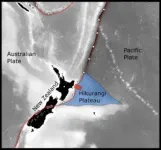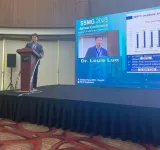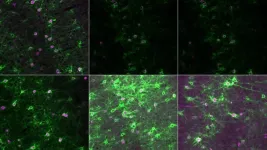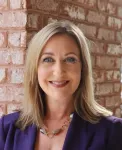(Press-News.org) Researchers have discovered a sea’s worth of water locked within the sediment and rock of a lost volcanic plateau that’s now deep in the Earth’s crust. Revealed by a 3D seismic image, the water lies two miles under the ocean floor off the coast of New Zealand, where it may be dampening a major earthquake fault that faces the country’s North Island.
The fault is known for producing slow-motion earthquakes, called slow slip events. These can release pent-up tectonic pressure harmlessly over days and weeks. Scientists want to know why they happen more often at some faults than others.
Many slow slip earthquakes are thought to be linked to buried water. However, until now there was no direct geologic evidence to suggest such a large water reservoir existed at this particular New Zealand fault.
“We can’t yet see deep enough to know exactly the effect on the fault, but we can see that the amount of water that's going down here is actually much higher than normal,” said the study’s lead author, Andrew Gase, who did the work as a postdoctoral fellow at the University of Texas Institute for Geophysics (UTIG).
The research was published in the journal Science Advances and is based on seismic cruises and scientific ocean drilling led by UTIG researchers.
Gase, who is now a postdoctoral fellow at Western Washington University, is calling for deeper drilling to find where the water ends up so that researchers can determine whether it affects pressure around the fault — an important piece of information that could lead to more precise understanding of large earthquakes, he said.
The site where the researchers found the water is part of a vast volcanic province that formed when a plume of lava the size of the United States breached the Earth’s surface in the Pacific Ocean 125 million years ago. The event was one of the Earth’s largest known volcanic eruptions and rumbled on for several million years.
Gase used seismic scans to build a 3D picture of the ancient volcanic plateau in which he saw thick, layered sediments surrounding buried volcanoes. His UTIG collaborators ran lab experiments on drill core samples of the volcanic rock and found that water made up nearly half of its volume.
“Normal ocean crust, once it gets to be about 7 or 10 million years old should contain much less water,” he said. The ocean crust in the seismic scans was ten times as old, but it had remained much wetter.
Gase speculates that the shallow seas where the eruptions took place eroded some of the volcanoes into a porous, broken-up rock that stored water like an aquifer as it was buried. Over time, the rock and rock fragments transformed into clay, locking in even more water.
The finding is important because scientists think that underground water pressure may be a key ingredient in creating conditions that release tectonic stress via slow slip earthquakes. This usually happens when water-rich sediments are buried with the fault, trapping the water underground. However, the New Zealand fault contains little of this typical ocean sediment. Instead, the researchers think the ancient volcanoes and the transformed rocks — now clays — are carrying large volumes of water down as they’re swallowed by the fault.
UTIG Director Demian Saffer, a study coauthor and co-chief scientist on the scientific drilling mission, said the findings suggest that other earthquake faults around the globe could be in similar situations.
“It’s a really clear illustration of the correlation between fluids and the style of tectonic fault movement — including earthquake behavior,” he said. “This is something that we've hypothesized from lab experiments, and is predicted by some computer simulations, but there are very few clear field experiments to test this at the scale of a tectonic plate.”
The research was funded by the U.S. National Science Foundation and science and research agencies in New Zealand, Japan and the United Kingdom.
END
Discovery of massive undersea water reservoir could explain New Zealand’s mysterious slow earthquakes
2023-10-04
ELSE PRESS RELEASES FROM THIS DATE:
Should fathers be screened for postpartum depression?
2023-10-04
Dads can suffer from postpartum depression, and a new pilot study at the University of Illinois Chicago suggests they can and should be screened for the condition. Given the intertwined effects of mothers’ and fathers’ physical and mental health, addressing the health of fathers may be a powerful untapped tool in improving the nation’s ongoing maternal health crisis.
The researchers got mothers’ permission to interview and screen 24 dads, 30% of whom screened positive for postpartum depression on the same tool ...
BGI Genomics breaks new ground in Saudi Arabian precision medicine
2023-10-04
The Saudi Society of Medical Genetics Annual Conference 2023 was held in Riyadh, Saudi Arabia, on September 29-30, 2023. As the most authoritative academic conference on precision medicine in the Kingdom, this conference attracted global experts worldwide.
One of the highlights of the conference was the presentation entitled "Spatial-temporal sequencing and some large-scale application of precision medicine technologies," delivered by Dr. Louis (Renyuan) Luo, VP of BGI Genomics West Asia, at the invitation of the Saudi Society of Medical Genetics.
Dr. Luo's presentation discussed the importance of spatiotemporal sequencing technology ...
Portable laboratory devices can detect SARS-CoV-2
2023-10-04
Washington, D.C. — A new study has demonstrated rapid and sensitive on-site detection of SARS-CoV-2 RNA from environmental surfaces using a portable laboratory device. The study was published in Microbiology Spectrum, a journal of the American Society for Microbiology.
“Our findings hold promising implications for scenarios where access to testing laboratories is challenging, such as in cruise ships, international travel, remote islands and tourist destinations,” said lead study author Kouichi Kitamura, Ph.D., National Institute of Infectious ...
Challenges in acute heart attack care continue post COVID-19
2023-10-04
A door-to-balloon (D2B) time of 90-minutes or less is associated with improved outcomes for heart attack patients. However, during the COVID-19 pandemic certain obstacles—including the need for COVID-19 screening, associated isolation procedures and terminal cleaning in the cardiac cath lab—led to increased D2B times. According to a new study, presented at the American College of Cardiology (ACC) Quality Summit 2023, many health care facilities are still recovering from the pandemic and facing new challenges, causing D2B times to continue to lag.
A myocardial infarction, or heart attack, occurs when there has been a blockage ...
Researchers design potential therapy to prevent brain deterioration in children with rare genetic conditions
2023-10-04
Francis Crick Institute press release
Under strict embargo: 14:00 BST / 09:00hrs ET Wednesday 4 October 2023
Peer reviewed
Observational and experimental studies
People and cells
A research team at the Francis Crick Institute and Great Ormond Street Hospital (GOSH)/UCL Great Ormond Street Institute of Child Health have identified new potential treatments for children with rare genetic conditions of blood vessels, which cause severe, lifelong, and disabling symptoms like seizures and impaired development.
Through two papers published today in the Journal of Investigative ...
Reactivate, repurpose, and rewire the brain
2023-10-04
Developing brains become shaped by the sights, sounds, and experiences of early life. The brain’s circuits grow more stable as we age. However, some experiences later in life open up opportunities for these circuits to be rapidly rewired. New research from Cold Spring Harbor Laboratory Associate Professor Stephen Shea helps explain how the brain adapts during a critical period of adulthood: the time when new mothers learn to care for their young.
Shea’s work in mice shows how this learning process ...
American Society for Metabolic and Bariatric Surgery names new executive director after yearlong search
2023-10-04
After a yearlong and extensive nationwide search, the American Society for Metabolic and Bariatric Surgery (ASMBS), the nation’s largest professional organization of bariatric and metabolic surgeons and integrated health professionals, has named healthcare association veteran Diane M. Enos MPH, RDN, CAE, FAND, to serve as its new executive director.
Before joining ASMBS, Enos, a registered dietitian and certified association executive with a master’s degree in public health from the University of Texas Health Science Center in Houston, was Chief Learning Officer of the Academy of Nutrition and Dietetics, ...
Antibody therapy inspired by patient case reduced tau tangles in a preclinical model of Alzheimer’s disease
2023-10-04
A team led by researchers from Mass General Brigham reports promising results for a monoclonal antibody that takes aim at a new target for Alzheimer’s disease. Inspired by their previous identification of a genetic variant in the APOE gene that provides extreme resistance against Alzheimer’s disease, the team, which includes investigators from Mass Eye and Ear and Massachusetts General Hospital, developed a therapy that mimics the behavior of this genetic variant in a preclinical model, reducing ...
Demystifying the role of plant x- and y-type thioredoxins
2023-10-04
The potential for exposure to fluctuating light has necessitated that plants evolve protective mechanisms for when the light intensity exceeds photosynthetic capacity. Under these conditions, reactive oxygen species cause photoinhibition, which hinders photosynthetic efficiency. To counter this loss in photosynthetic efficiency, chloroplasts evolved thioredoxin (Trx) proteins that regulate redox balance within the photosynthetic apparatus and provide a photoprotective function. These proteins allow plants to modulate photosynthesis in response to variations in light intensity. ...
Graphene oxide reduces the toxicity of Alzheimer’s proteins
2023-10-04
A probable early driver of Alzheimer's disease is the accumulation of molecules called amyloid peptides. These cause cell death, and are commonly found in the brains of Alzheimer’s patients. Researchers at Chalmers University of Technology, Sweden, have now shown that yeast cells that accumulate these misfolded amyloid peptides can recover after being treated with graphene oxide nanoflakes.
Alzheimer’s disease is an incurable brain disease, leading to dementia and death, that causes suffering for both the patients and their ...







